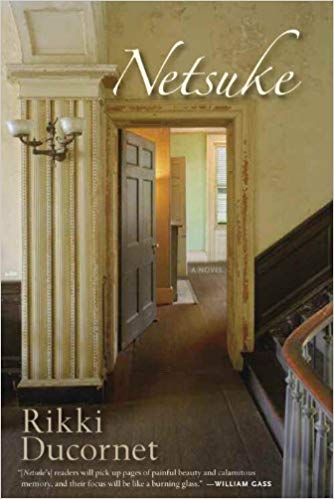
Netsuke, by Rikki Ducornet – Coffee House Press. The psychoanalyst is not well. He could benefit from some of his own therapy, but lacks the insight to seek help. Perhaps we might best describe his difficulty thus: he confuses desire and obsession; what he takes for passionate feeling is something more mechanical and needless, like the hunger of a glutton.
The psychoanalyst exploits his position to satisfy his hunger. He keeps two separate offices on his property. One, he calls Drear, and meets there with patients who do not interest him. The other, he calls Spells, and uses this space to seduce patients who excite him. In Spells, he keeps a curio cabinet where he displays a collection of netsuke, exquisite Japanese carvings, many quite old, all quite expensive. The netsuke are like Osmond’s bibelots in Portrait of a Lady. Osmond desired Isabel as he desired his bibelots; she was a beautiful object he could put on display. In the same way, the psychoanalyst desires his patients as he desires his netsuke; they are the objects of an obsession and he seeks to possess them.
The psychoanalyst is assisted by his third wife, Akiko. She is an accomplished artist and more knowledgeable in the matter of collecting things. Ducornet does not give us precise details about their relationship, and so we are left to infer for ourselves the nature of its dysfunctions. Given that Akiko is Japanese, it is fair to assume that we are to draw some kind of a connection between her and the collection of netsuke. Perhaps Akiko is a netsuke and, like Osmond’s Isabel, just another objet d’art. Or perhaps her role is more complex. She appears passive in their relationship; she ignores the many clues he deliberately drops in her path; yet surely she cannot be so naïve. She must know what her husband is doing when he stays late at Spells. If so, then there must be a sense in which, by her acquiescence, she enables her husband’s infidelities.
The novel itself is a netsuke. After all, that is its title. Like a netsuke, it adheres to aesthetic conventions while revealing Ducornet’s unique skills. She writes in a spare prose that reveals an appreciation for that most Japanese of qualities – delicacy, the careful presentation of psychological nuance. Like her unnamed narrator, she drops clues for us, vague intimations which we use to construct a fuller character. Although the psychoanalyst’s compulsion could be described as sex addiction, there is a sadistic tinge to his behaviour. He takes a certain relish, not so much in the risk of getting caught, as in the possibility of inflicting harm. He is at his most cruel with a patient he calls the Cutter. When he takes his wife to a restaurant where the Cutter is likely to be dining, he is well aware that a meeting will likely set the woman off. Yet he does it anyways.
In the second half of the book, the psychoanalyst loses control. Ducornet drops clues to signal the change. The feeling of delicacy vanishes. The narrative shifts from first to third person. And so we watch her netsuke shatter. What precipitates the change is the appearance of a new patient named David Swancourt. oung, physically attractive, the narrator finds himself sexually aroused by the new patient. David Swancourt is also a woman named Jello. At this point, it becomes difficult to parse what is happening to the psychoanalyst. It could be a matter of narcissism—an attraction to a younger iteration of himself. Or it could be a crisis of sexual identity as the psychoanalyst finds his customary attractions challenged. That would certainly account for the sadistic nature of his relations with women. It could also be a crisis of a different sort: the psychoanalyst finally encounters a degree of intimacy that makes him happy, but can’t have that intimacy without self-destructing. David Swancourt/Jello is one of the terrifying netsuke, an anomaly, like the “two wasps devouring the flesh of a fig.” We still admire and value the netsuke even as it repulses us, because it has been executed with a fierce commitment to the creation of a singular object.
If we haven’t the stomach for the novel’s psychological ferocity, then we still have recourse to the words themselves. Take, for example, this lovely play between the domestic and the mythic (with the obvious phallic imagery stuck right in the middle of everything):
On the drive home he decides that Akiko’s ordered life is anomalous. He thinks: I carry the tower within me. An old story. An ancient story. A story inscribed in the Book of Nature from the start. The world was born in confusion, in confusion it proceeds, in confusion it will fall.
Continuing with the phallic imagery, I find myself arrested by the correlation Ducornet draws between the penis and the pen:
When he dabbed the pen’s tip with a small square of blotting paper, she saw that the gesture was exactly the one he used after taking a piss, holding his cock in one hand and soaking up the last drop of urine with a folded tissue.
This presents an interesting variation on an old theme which ties creativity to the genitalia, and while tradition ties it to the procreative function of the genitalia, there is a growing tendency to roll up our excretory functions in the metaphor. Was it not Brecht whose Baal said that God had declared His true nature by “combining the sexual organ with the urinary tract”? And more recently, did Milan Kundera not expose the necessity of shit for the creation of art, without which there is only kitsch? Ducornet extends that tradition, offering a work that represents a whole body, a complete digestive tract in full working order, accommodating both hunger and excretion. Although sometimes terrible to behold, it enjoys a completeness that most novels fail to achieve.
